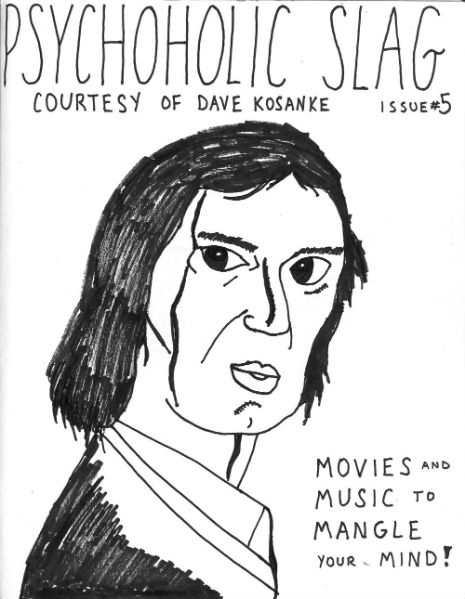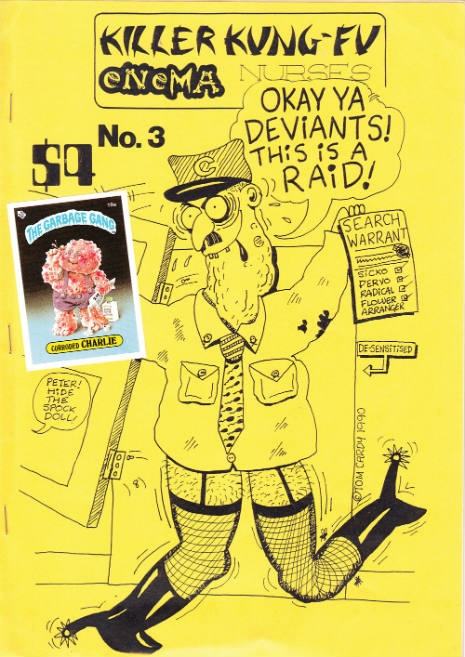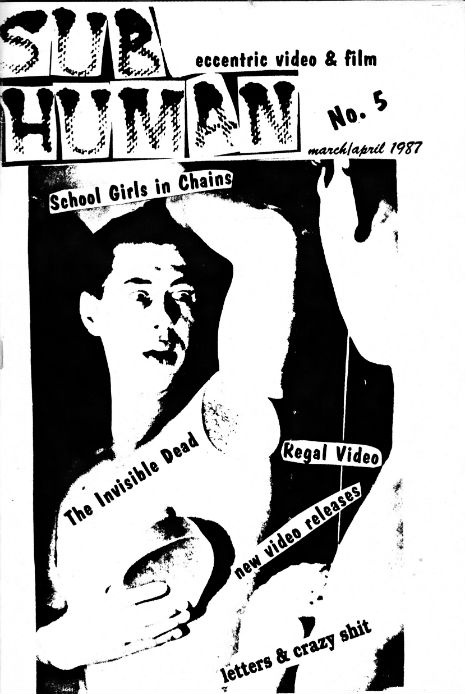
Guest post by David Kerekes, co-author of Killing For Culture and See No Evil, and author of Mezzogiorno
In the introduction to a new book on the subject of horror film fanzines and the culture they spawned, author John Szpunar deliberates on the place of the zine next to mainstream media. There is a difference, he says, in that the zines had nothing to lose.
I can think of no better example to illustrate this point than a Myra Hindley cut out doll. It’s a pen and ink drawing gracing the back cover of Subhuman #4 (January 1987), which shows one half of the Moors Murderers wearing nothing but her fearsome peroxide bouffant and black panties. A change of dress includes a Nazi uniform along with a bloodstained kitchen knife as accessory.

Art: Jason Knight
The Myra doll isn’t trying to sell anything. It doesn’t relate to a film, nor bear any relation to the content of the zine in question. Its simple purpose is to glower with gentle contempt. In the town I once lived, a short bus ride from the moors of the Moors Murderers, this sort of jape could get you lynched. Who in their right mind would conjure up something as disturbing, disposable and quite as brilliant as a Myra Hindley cut out doll? Disposable is a clue, in deference to the type of horror fanzine one might find in John Szpunar’s book.
To paraphrase the jacket blurb, Xerox Ferox: The Wild World of the Horror Film Fanzine is a book that covers a scene that has influenced generations of writers, filmmakers and fans (myself included; I published it). Fanzines with lurid titles like Gore Gazette, Violent Leisure, Sleazoid Express and Subhuman expressed a sense of freak camaraderie at a time when technology was yet to arrive for its wholesale delivery of freak. Theirs was a literary DIY ethos, not dissimilar to that of punk rock a decade or so earlier (which incidentally often borrowed from film, particularly cult and horror film).

Psychoholic Slag. Issue 5 (USA). Argento! Argento? Editor: Dave Kosanke.
One zine usually opened the door to other zines. Writes John Szpunar of his own education in this respect:
Before long, I was a part of a network of zine and tape traders, and the goods kept rolling in […] I was coming of age with the help of a new generation, and I was having the time of my life.
Avoiding reference to literary content for the moment (irreverent… informed… typo laden), the thing most striking about the horror film zines is, of course, the visual aesthetic. Although some were designed to a comparatively high standard—i.e., pro-zines like CineFan, Little Shoppe of Horrors and Bizarre —many more were low key efforts of short runs that were perhaps given away for the price of postage. The layouts were urgent and witty, overloaded with elements seemingly vying for space before the page ran out. And defining these products was the photocopier, the Xerox of Xerox Ferox, creating an arresting visual dynamic of harsh black and white contrasts that robbed any image of superfluous detail.
It is reassuring to discover that, in the age of the Internet, a small place still exists for the zine practitioner and the horror film culture of the printed page. Examples are out there, being transmitted through the postal network in a matter of days to defy the blogosphere (a term so abhorrent we are destined to use it). For now, however, a random collection of horror fanzine covers rescued from the mailboxes of old and made suitable for framing…
Get a special hardback edition of the remarkable Xerox Ferox here. 800 fully illustrated pages, about $72 plus a couple more to post. Pre-release paperback available here.

Killer Kung Fu Enema Nurses On Crack Issue 3 (NZ). A genuine Garbage Pail Kids sticker adorns the cover. Image depicts a police raid on the New Zealand home of editor/publisher Peter Hassall, confiscating books, zines and porn.

Subhuman Issue 5, March/April 1987 (USA). Design: Dawn Doyle. Editor: Cecil Doyle.

Trash Compactor Volume 2 Issue 4, Winter 1990 (CAN). Design: The Trash Compactor.